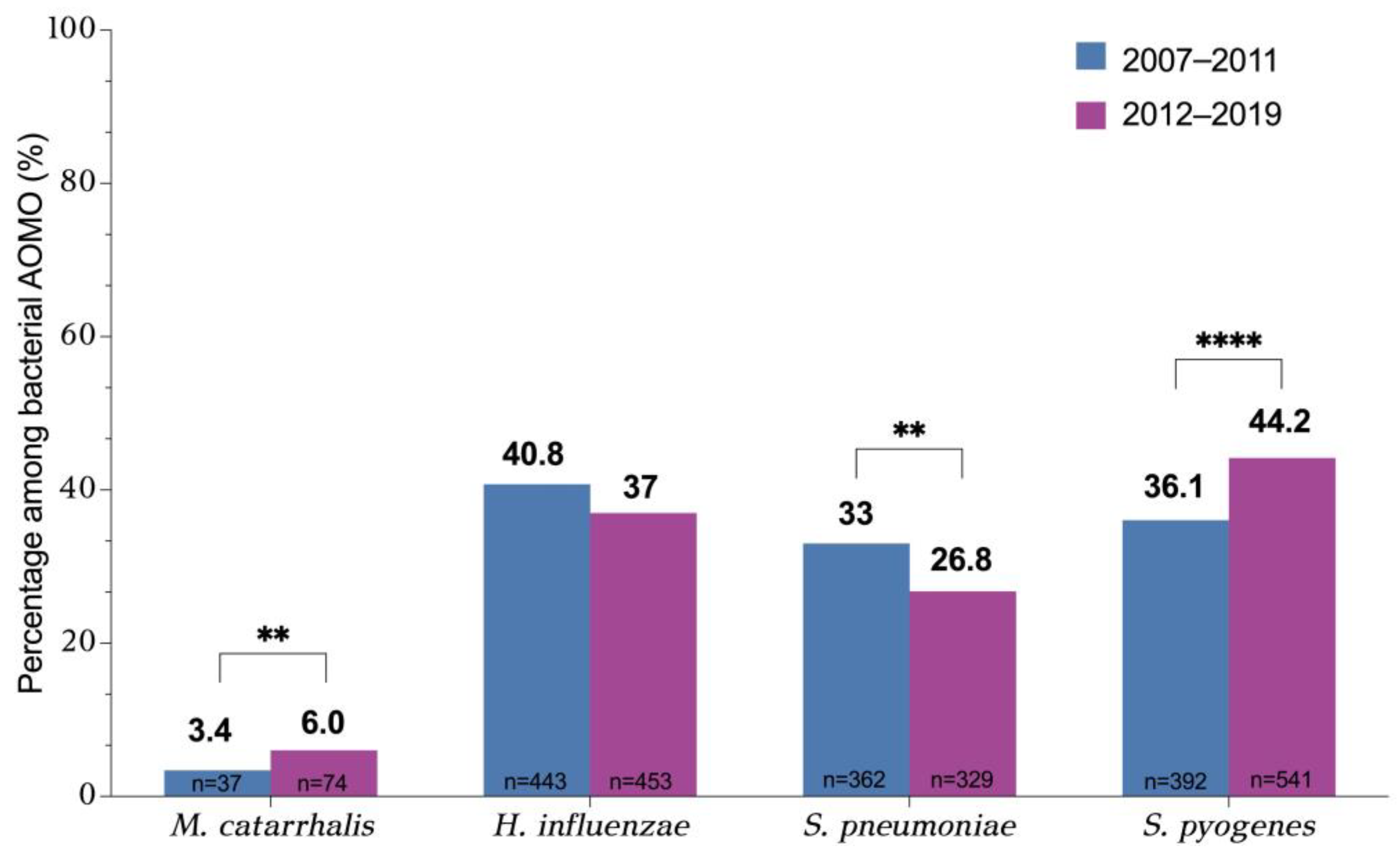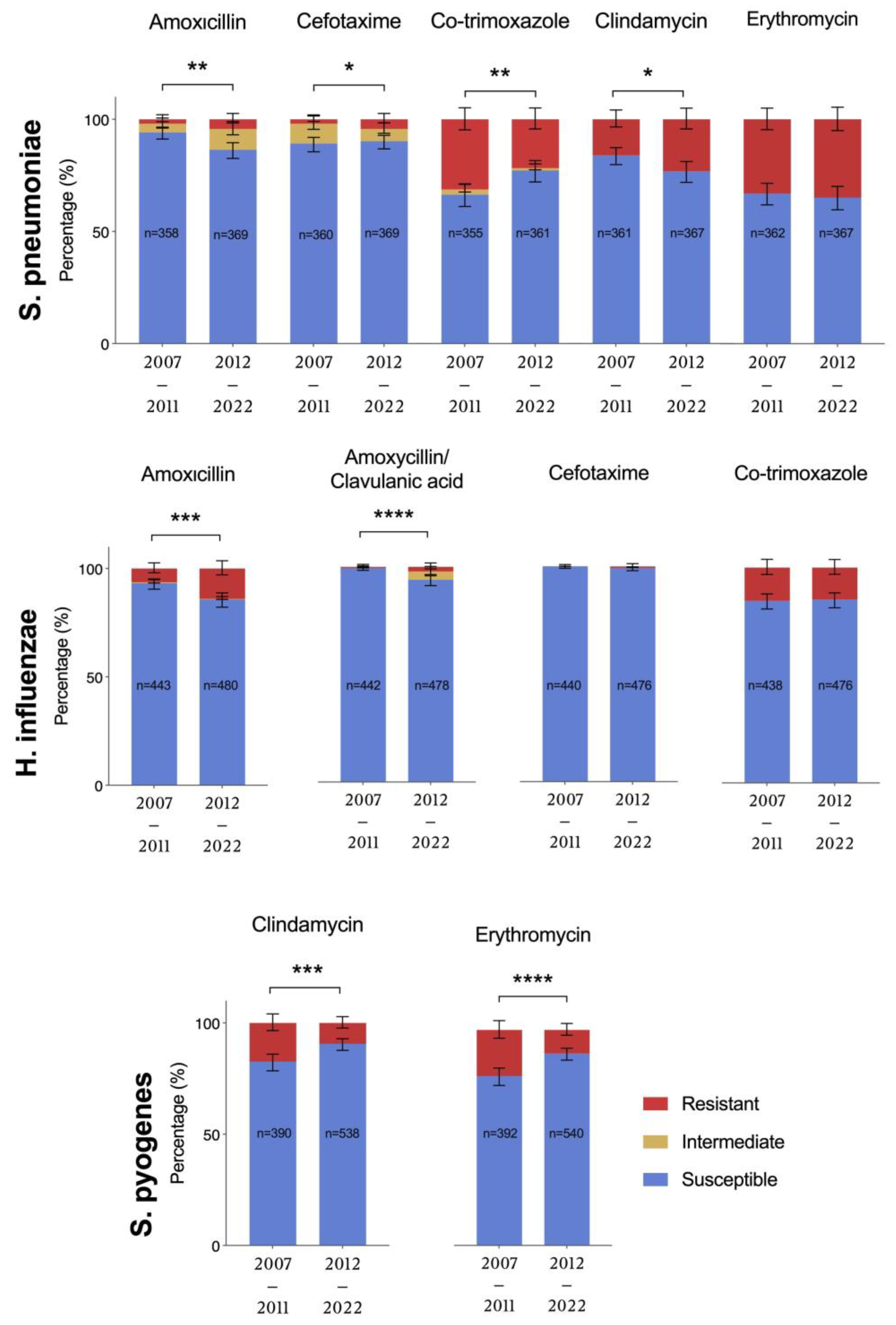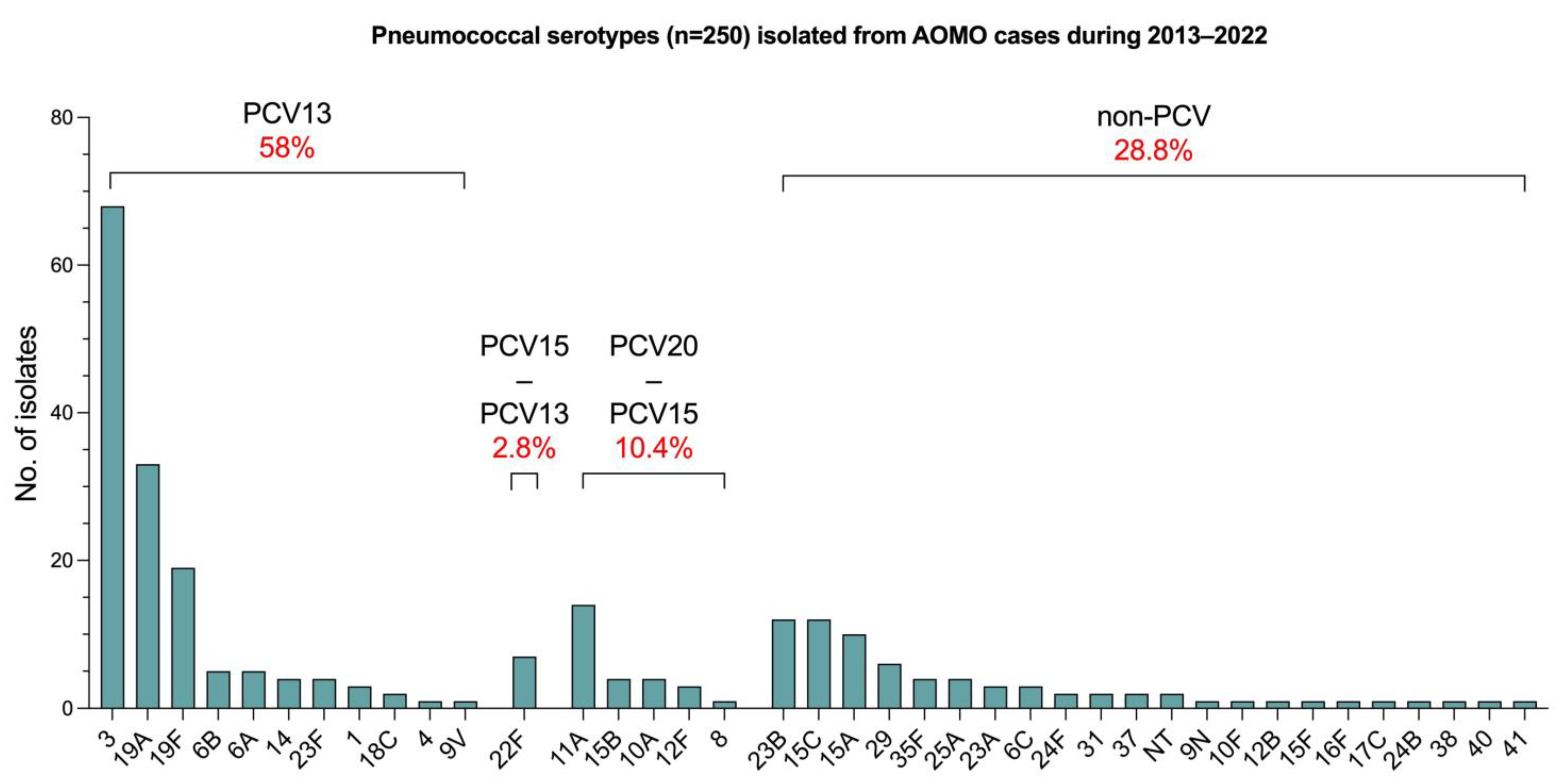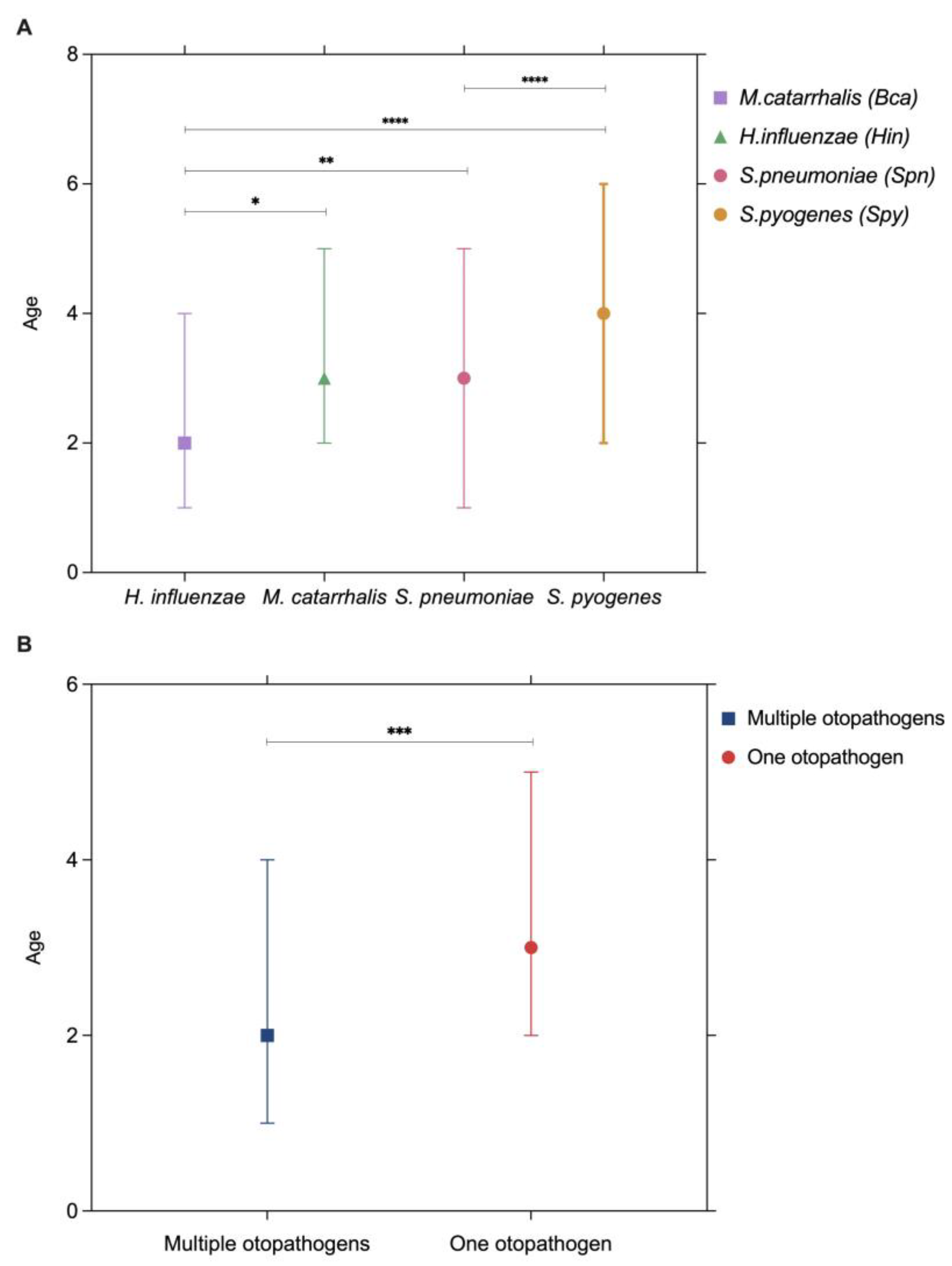Bacterial Acute Otitis Media Complicated with Otorrhea in a Children’s Hospital in the Era of Pneumococcal Conjugate Vaccines
Abstract
1. Introduction
2. Materials and Methods
2.1. Microbiology
2.2. Statistical Analysis
3. Results
3.1. Participant Characteristics
3.2. Comparison of Pathogen Frequency Among AOMO Cases Between the Two PCV Periods
3.3. Comparison of the Antimicrobial Susceptibility of Isolated Pathogens
3.4. Pneumococcal Serotypes
4. Discussion
5. Conclusions
6. Take-Home Messages
- Serotype replacement is an ongoing phenomenon in pneumococcal circulation, even in communities with high vaccine coverage, and influences the etiology of common pediatric infections such as AOMO.
- Following widespread PCV13 use, H. influenzae and S. pyogenes have emerged as leading causes of AOM with otorrhea, underlining the shifting etiology of pediatric ear infections.
- Serotype 3 remains a dominant pneumococcal strain despite PCV13 coverage, highlighting the need for next-generation vaccines or improved immunogenicity against this serotype.
- Coordinated strategies that combine vaccination, surveillance, and antibiotic stewardship are essential to maintain gains in disease prevention and to control antimicrobial resistance.
Supplementary Materials
Author Contributions
Funding
Institutional Review Board Statement
Informed Consent Statement
Data Availability Statement
Conflicts of Interest
Abbreviations
| AOM | Acute otitis media |
| AOMO | Acute otitis media with otorrhea |
| COVID-19 | Coronavirus disease 2019 |
| ENT | Ear–nose–throat |
| MEF | Middle ear fluid |
| PCV | Pneumococcal conjugate vaccine |
| PCV7 | 7-valent pneumococcal conjugate vaccine |
| PCV13 | 13-valent pneumococcal conjugate vaccine |
| AOM | Acute otitis media |
References
- Todberg, T.; Koch, A.; Andersson, M.; Olsen, S.F.; Lous, J.; Homøe, P. Incidence of Otitis Media in a Contemporary Danish National Birth Cohort. PLoS ONE 2014, 9, e111732. [Google Scholar] [CrossRef]
- Vergison, A.; Dagan, R.; Arguedas, A.; Bonhoeffer, J.; Cohen, R.; DHooge, I.; Hoberman, A.; Liese, J.; Marchisio, P.; Palmu, A.A.; et al. Otitis Media and Its Consequences: Beyond the Earache. Lancet Infect. Dis. 2010, 10, 195–203. [Google Scholar] [CrossRef] [PubMed]
- Greenberg, D.; Bilenko, N.; Liss, Z.; Shagan, T.; Zamir, O.; Dagan, R. The Burden of Acute Otitis Media on the Patient and the Family. Eur. J. Pediatr. 2003, 162, 576–581. [Google Scholar] [CrossRef] [PubMed]
- Wolleswinkel-van den Bosch, J.H.; Stolk, E.A.; Francois, M.; Gasparini, R.; Brosa, M. The Health Care Burden and Societal Impact of Acute Otitis Media in Seven European Countries: Results of an Internet Survey. Vaccine 2010, 28, G39–G52. [Google Scholar] [CrossRef]
- van Uum, R.T.; Venekamp, R.P.; Pasmans, C.T.B.; de Wit, G.A.; Sjoukes, A.; van der Pol, A.C.; Damoiseaux, R.A.M.J.; Schilder, A.G.M. Cost of Childhood Acute Otitis Media in Primary Care in the Netherlands: Economic Analysis alongside a Cluster Randomised Controlled Trial. BMC Health Serv. Res. 2021, 21, 193. [Google Scholar] [CrossRef] [PubMed]
- Tong, S.; Amand, C.; Kieffer, A.; Kyaw, M.H. Trends in Healthcare Utilization and Costs Associated with Acute Otitis Media in the United States during 2008–2014. BMC Health Serv. Res. 2018, 18, 318. [Google Scholar] [CrossRef]
- Schilder, A.G.M.; Chonmaitree, T.; Cripps, A.W.; Rosenfeld, R.M.; Casselbrant, M.L.; Haggard, M.P.; Venekamp, R.P. Otitis Media. Nat. Rev. Dis. Primers 2016, 2, 16063. [Google Scholar] [CrossRef]
- Rovers, M.M.; Schilder, A.G.; Zielhuis, G.A.; Rosenfeld, R.M. Otitis Media. Lancet 2004, 363, 465–473. [Google Scholar] [CrossRef]
- Ahmed, S.; Shapiro, N.L.; Bhattacharyya, N. Incremental Health Care Utilization and Costs for Acute Otitis Media in Children. Laryngoscope 2014, 124, 301–305. [Google Scholar] [CrossRef]
- Coker, T.R.; Chan, L.S.; Newberry, S.J.; Limbos, M.A.; Suttorp, M.J.; Shekelle, P.G.; Takata, G.S. Diagnosis, Microbial Epidemiology, and Antibiotic Treatment of Acute Otitis Media in Children: A Systematic Review. JAMA 2010, 304, 2161–2169. [Google Scholar] [CrossRef]
- Kourlaba, G.; Kourkouni, E.; Spyridis, N.; Gerber, J.S.; Kopsidas, J.; Mougkou, K.; Lourida, A.; Zaoutis, T.E. Antibiotic Prescribing and Expenditures in Outpatient Paediatrics in Greece, 2010–2013. J. Antimicrob. Chemother. 2015, 70, 2405–2408. [Google Scholar] [CrossRef] [PubMed]
- Rovers, M.M.; Glasziou, P.; Appelman, C.L.; Burke, P.; McCormick, D.P.; Damoiseaux, R.A.; Gaboury, I.; Little, P.; Hoes, A.W. Antibiotics for Acute Otitis Media: A Meta-Analysis with Individual Patient Data. Lancet 2006, 368, 1429–1435. [Google Scholar] [CrossRef]
- Smith, L.; Ewings, P.; Smith, C.; Thompson, M.; Harnden, A.; Mant, D. Ear Discharge in Children Presenting with Acute Otitis Media: Observational Study from UK General Practice. Br. J. Gen. Pract. 2010, 60, 101–105. [Google Scholar] [CrossRef] [PubMed]
- Ngo, C.C.; Massa, H.M.; Thornton, R.B.; Cripps, A.W. Predominant Bacteria Detected from the Middle Ear Fluid of Children Experiencing Otitis Media: A Systematic Review. PLoS ONE 2016, 11, e0150949. [Google Scholar] [CrossRef]
- Jacobs, M.R.; Dagan, R.; Appelbaum, P.C.; Burch, D.J. Prevalence of Antimicrobial-Resistant Pathogens in Middle Ear Fluid: Multinational Study of 917 Children with Acute Otitis Media. Antimicrob. Agents Chemother. 1998, 42, 589–595. [Google Scholar] [CrossRef]
- de Sévaux, J.L.; Venekamp, R.P.; Lutje, V.; Hak, E.; Schilder, A.G.; Sanders, E.A.; Damoiseaux, R.A. Pneumococcal Conjugate Vaccines for Preventing Acute Otitis Media in Children. Cochrane Database Syst. Rev. 2020, 11, CD001480. [Google Scholar] [CrossRef] [PubMed]
- Ben-Shimol, S.; Givon-Lavi, N.; Leibovitz, E.; Raiz, S.; Greenberg, D.; Dagan, R. Impact of Widespread Introduction of Pneumococcal Conjugate Vaccines on Pneumococcal and Nonpneumococcal Otitis Media. Clin. Infect. Dis. 2016, 63, 611–618. [Google Scholar] [CrossRef]
- Sartori, A.L.; Minamisava, R.; Bierrenbach, A.L.; Toscano, C.M.; Afonso, E.T.; Morais-Neto, O.L.; Antunes, J.L.F.; Cristo, E.B.; Andrade, A.L. Reduction in All-Cause Otitis Media-Related Outpatient Visits in Children after PCV10 Introduction in Brazil. PLoS ONE 2017, 12, e0179222. [Google Scholar] [CrossRef]
- Lau, W.C.Y.; Murray, M.; El-Turki, A.; Saxena, S.; Ladhani, S.; Long, P.; Sharland, M.; Wong, I.C.K.; Hsia, Y. Impact of Pneumococcal Conjugate Vaccines on Childhood Otitis Media in the United Kingdom. Vaccine 2015, 33, 5072–5079. [Google Scholar] [CrossRef]
- Gisselsson-Solen, M. Trends in Otitis Media Incidence After Conjugate Pneumococcal Vaccination: A National Observational Study. Pediatr. Infect. Dis. J. 2017, 36, 1027–1031. [Google Scholar] [CrossRef]
- Stamboulidis, K.; Chatzaki, D.; Poulakou, G.; Ioannidou, S.; Lebessi, E.; Katsarolis, I.; Sypsa, V.; Tsakanikos, M.; Kafetzis, D.; Tsolia, M.N. The Impact of the Heptavalent Pneumococcal Conjugate Vaccine on the Epidemiology of Acute Otitis Media Complicated by Otorrhea. Pediatr. Infect. Dis. J. 2011, 30, 551–555. [Google Scholar] [CrossRef] [PubMed]
- Levy, C.; Varon, E.; Ouldali, N.; Wollner, A.; Thollot, F.; Corrard, F.; Werner, A.; Béchet, S.; Bonacorsi, S.; Cohen, R. Bacterial Causes of Otitis Media with Spontaneous Perforation of the Tympanic Membrane in the Era of 13 Valent Pneumococcal Conjugate Vaccine. PLoS ONE 2019, 14, e0211712. [Google Scholar] [CrossRef]
- Pichichero, M.; Kaur, R.; Scott, D.A.; Gruber, W.C.; Trammel, J.; Almudevar, A.; Center, K.J. Effectiveness of 13-Valent Pneumococcal Conjugate Vaccination for Protection against Acute Otitis Media Caused by Streptococcus Pneumoniae in Healthy Young Children: A Prospective Observational Study. Lancet Child Adolesc. Health 2018, 2, 561–568. [Google Scholar] [CrossRef] [PubMed]
- Ben-Shimol, S.; Givon-Lavi, N.; Leibovitz, E.; Raiz, S.; Greenberg, D.; Dagan, R. Near-Elimination of Otitis Media Caused by 13-Valent Pneumococcal Conjugate Vaccine (PCV) Serotypes in Southern Israel Shortly after Sequential Introduction of 7-Valent/13-Valent PCV. Clin. Infect. Dis. 2014, 59, 1724–1732. [Google Scholar] [CrossRef] [PubMed]
- Leibovitz, E.; Serebro, M.; Givon-Lavi, N.; Greenberg, D.; Broides, A.; Leiberman, A.; Dagan, R. Epidemiologic and Microbiologic Characteristics of Culture-Positive Spontaneous Otorrhea in Children with Acute Otitis Media. Pediatr. Infect. Dis. J. 2009, 28, 381–384. [Google Scholar] [CrossRef]
- Wiese, A.D.; Huang, X.; Yu, C.; Mitchel, E.F.; Kyaw, M.H.; Griffin, M.R.; Grijalva, C.G. Changes in Otitis Media Episodes and Pressure Equalization Tube Insertions Among Young Children Following Introduction of the 13-Valent Pneumococcal Conjugate Vaccine: A Birth Cohort–Based Study. Clin. Infect. Dis. 2019, 69, 2162–2169. [Google Scholar] [CrossRef]
- Soysal, A.; Gönüllü, E.; Yıldız, I.; Aydemir, G.; Tunç, T.; Fırat, Y.; Erdamar, B.; Karaböcüoğlu, M. Impact of the 13-Valent Pneumococcal Conjugate Vaccine on the Incidences of Acute Otitis Media, Recurrent Otitis Media and Tympanostomy Tube Insertion in Children after Its Implementation into the National Immunization Program in Turkey. Hum. Vaccin. Immunother. 2020, 16, 445–451. [Google Scholar] [CrossRef]
- Andrejko, K.; Ratnasiri, B.; Hausdorff, W.P.; Laxminarayan, R.; Lewnard, J.A. Antimicrobial Resistance in Paediatric Streptococcus Pneumoniae Isolates amid Global Implementation of Pneumococcal Conjugate Vaccines: A Systematic Review and Meta-Regression Analysis. Lancet Microbe 2021, 2, e450–e460. [Google Scholar] [CrossRef]
- Mather, M.W.; Drinnan, M.; Perry, J.D.; Powell, S.; Wilson, J.A.; Powell, J. A Systematic Review and Meta-Analysis of Antimicrobial Resistance in Paediatric Acute Otitis Media. Int. J. Pediatr. Otorhinolaryngol. 2019, 123, 102–109. [Google Scholar] [CrossRef]
- Pichichero, M.; Malley, R.; Kaur, R.; Zagursky, R.; Anderson, P. Acute Otitis Media Pneumococcal Disease Burden and Nasopharyngeal Colonization in Children Due to Serotypes Included and Not Included in Current and New Pneumococcal Conjugate Vaccines. Expert. Rev. Vaccines 2023, 22, 118–138. [Google Scholar] [CrossRef]
- CDC. ABCs Bact Facts Interactive Data Dashboard|National Center for Immunization and Respiratory Diseases, Division of Bacterial Diseases. Available online: https://www.cdc.gov/abcs/bact-facts/data-dashboard.html?CDC_AAref_Val=https://www.cdc.gov/abcs/bact-facts-interactive-dashboard.html (accessed on 14 September 2023).
- Hellenic Center for Disease Control and Prevention (HCDCP). Hellenic Society of Infectious Diseases Κατευθυντήριες Oδηγίες για τη Διάγνωση και τη Θεραπεία των Λοιμώξεων [Guidelines for the Diagnosis and Treatment of Infections]; Hellenic Center for Disease Control and Prevention: Athens, Greece, 2015. [Google Scholar]
- Grivea, I.N.; Syrogiannopoulos, G.A.; Michoula, A.N.; Gazeti, G.; Malli, E.; Tsilipounidaki, K.; Fouzas, S.; Anthracopoulos, M.B.; Petinaki, E. Emm Types and Clusters and Macrolide Resistance of Pediatric Group A Streptococcal Isolates in Central Greece during 2011–2017. PLoS ONE 2020, 15, e0232777. [Google Scholar] [CrossRef] [PubMed]
- Michos, A.; Koutouzi, F.I.; Tsakris, A.; Chatzichristou, P.; Koutouzis, E.I.; Daikos, G.L.; Stathi, A.; Syriopoulou, V.P. Molecular Analysis of Streptococcus Pyogenes Macrolide Resistance of Paediatric Isolates during a 7 Year Period (2007-13). J. Antimicrob. Chemother. 2016, 71, 2113–2117. [Google Scholar] [CrossRef] [PubMed]
- Adriaenssens, N.; Bruyndonckx, R.; Versporten, A.; Hens, N.; Monnet, D.L.; Molenberghs, G.; Goossens, H.; Weist, K.; Coenen, S. Consumption of Macrolides, Lincosamides and Streptogramins in the Community, European Union/European Economic Area, 1997–2017. J. Antimicrob. Chemother. 2021, 76, 30–36. [Google Scholar] [CrossRef] [PubMed]
- Michos, A.; Tatsi, E.B.; Dourdouna, M.-M.; Dellis, C.; Rizou, A.; Georgakopoulou, T.; Paradises, G.; Stathi, A.; Doudoulakakis, A.; Kalogeras, G.; et al. Genomic Characterization of Group A Streptococcus Isolates Circulating among Children in Greece during 2023. In Proceedings of the IDWeek, Los Angeles, CA, USA, 16–19 October 2024. [Google Scholar]
- Principi, N.; Marchisio, P.; Rosazza, C.; Sciarrabba, C.S.; Esposito, S. Acute Otitis Media with Spontaneous Tympanic Membrane Perforation. Eur. J. Clin. Microbiol. Infect. Dis. 2017, 36, 11–18. [Google Scholar] [CrossRef]
- ECDC. Invasive Pneumococcal Disease—Annual Epidemiological Report for 2022; ECDC: Solna, Sweden, 2025. [Google Scholar]
- Narciso, A.R.; Dookie, R.; Nannapaneni, P.; Normark, S.; Henriques-Normark, B. Streptococcus Pneumoniae Epidemiology, Pathogenesis and Control. Nat. Rev. Microbiol. 2024, 23, 256–271. [Google Scholar] [CrossRef]
- Syrogiannopoulos, G.A.; Michoula, A.N.; Moriondo, M.; Nieddu, F.; Syrogiannopoulou, T.G.; Anthracopoulos, M.B.; Petinaki, E.; Azzari, C.; Grivea, I.N. Childhood Invasive Pneumococcal Disease and Acute Otitis Media in Central Greece during 2005–2024—A Report at the Doorstep of the New Multivalent PCV Era. Vaccine 2025, 52, 126765. [Google Scholar] [CrossRef]
- Silva-Costa, C.; Brito, M.J.; Pinho, M.D.; Friães, A.; Aguiar, S.I.; Ramirez, M.; Melo-Cristino, J. Pediatric Complicated Pneumonia Caused by Streptococcus Pneumoniae Serotype 3 in 13-Valent Pneumococcal Conjugate Vaccinees, Portugal, 2010–2015. Emerg. Infect. Dis. 2018, 24, 1307–1314. [Google Scholar] [CrossRef]
- Papachristidou, S.; Lapea, V.; Charisi, M.; Kourkouni, E.; Kousi, D.; Xirogianni, A.; Dedousi, O.; Papaconstadopoulos, I.; Eleftheriou, E.; Krepis, P.; et al. A Multicenter Study on the Epidemiology of Complicated Parapneumonic Effusion in the Era of Currently Available Pneumococcal Conjugate Vaccines. Vaccine 2023, 41, 6727–6733. [Google Scholar] [CrossRef]
- Luck, J.N.; Tettelin, H.; Orihuela, C.J. Sugar-Coated Killer: Serotype 3 Pneumococcal Disease. Front. Cell. Infect. Microbiol. 2020, 10, 613287. [Google Scholar] [CrossRef]
- Ruiz García, Y.; Nieto Guevara, J.; Izurieta, P.; Vojtek, I.; Ortega-Barría, E.; Guzman-Holst, A. Circulating Clonal Complexes and Sequence Types of Streptococcus Pneumoniae Serotype 19A Worldwide: The Importance of Multidrug Resistance: A Systematic Literature Review. Expert. Rev. Vaccines 2021, 20, 45–57. [Google Scholar] [CrossRef]
- Almeida, S.C.G.; Lemos, A.P.S.d.; Bierrenbach, A.L.; Moraes, J.C.d.; Brandileone, M.C.d.C. Serotype Distribution and Antimicrobial Susceptibility Pattern of Streptococcus Pneumoniae in COVID-19 Pandemic Era in Brazil. Microorganisms 2024, 12, 401. [Google Scholar] [CrossRef] [PubMed]
- Lee, M.-R.; Chen, C.-M.; Chuang, T.-Y.; Huang, Y.-T.; Hsueh, P.-R. Capsular Serotypes and Antimicrobial Susceptibilities of Streptococcus Pneumoniae Causing Invasive Pneumococcal Disease from 2009–2012 with an Emphasis on Serotype 19A in Bacteraemic Pneumonia and Empyema and β-Lactam Resistance. Int. J. Antimicrob. Agents 2013, 42, 395–402. [Google Scholar] [CrossRef] [PubMed]
- Papamichail, D.; Petraki, I.; Arkoudis, C.; Terzidis, A.; Smyrnakis, E.; Benos, A.; Panagiotopoulos, T. Low Vaccination Coverage of Greek Roma Children amid Economic Crisis: National Survey Using Stratified Cluster Sampling. Eur. J. Public Health 2017, 27, 318–324. [Google Scholar] [CrossRef]
- Tasika, E.; Farmaki, E.; Roilides, E.; Antachopoulos, C. Implementation of the Greek National Immunization Program among Nursery Attendees in the Urban Area of Thessaloniki. Hippokratia 2019, 23, 147–153. [Google Scholar] [PubMed]
- Vassiliki, P.; Ioanna, K.; Artemis, V.; Eleni, K.; Aglaia, Z.; Attilakos, A.; Maria, T.; Dimitris, K. Determinants of Vaccination Coverage and Adherence to the Greek National Immunization Program among Infants Aged 2–24 Months at the Beginning of the Economic Crisis (2009–2011). BMC Public Health 2014, 14, 1192. [Google Scholar] [CrossRef]
- Georgakopoulou, T.; Menegas, D.; Katsioulis, A.; Theodoridou, M.; Kremastinou, J.; Hadjichristodoulou, C. A Cross-Sectional Vaccination Coverage Study in Preschool Children Attending Nurseries-Kindergartens: Implications on Economic Crisis Effect. Hum. Vaccin. Immunother. 2017, 13, 190–197. [Google Scholar] [CrossRef]
- Zografaki, E.; Panagiotopoulos, T.; Papamichail, D.; Georgakopoulou, T.; Theodoridou, M.; Papaevangelou, V.; Pavlopoulou, I.; Stavrou, D.; Tsolakidis, A.; Fotiadou, E. Eκτίμηση της Εμβολιαστικής Κάλυψης των Παιδιών στην Ελλάδα από Στοιχεία της Hλεκτρονικής Συνταγογράφησης [Assessment of Vaccination Coverage in Children in Greece Based on Data from the Electronic Prescription System]; University of West Attica Department of Public Health Policy: Athens, Greece, 2024. [Google Scholar]




| Age, Median (IQR) | p-Value | Females, N (%) | p-Value | |
|---|---|---|---|---|
| S. pneumoniae | 3 (1–5) | <0.001 ^ | 261 (43.4) | 0.54 † |
| H. influenzae | 2 (1–4) | 308 (41.1) | ||
| S. pyogenes | 4 (2–6) | 402 (44.3) | ||
| M. catarrhalis | 3 (2–5) | 24 (39.3) | ||
| Single-pathogen episodes | 3 (2–5) | 0.001 ^^ | 996 (42.9) | 0.476 † |
| Polymicrobial episodes (>1 pathogen) | 2 (1–4) | 88 (45.6) | ||
| Total culture-positive AOMO cases | 3 (1–5) | 1084 (43.2) |
Disclaimer/Publisher’s Note: The statements, opinions and data contained in all publications are solely those of the individual author(s) and contributor(s) and not of MDPI and/or the editor(s). MDPI and/or the editor(s) disclaim responsibility for any injury to people or property resulting from any ideas, methods, instructions or products referred to in the content. |
© 2025 by the authors. Licensee MDPI, Basel, Switzerland. This article is an open access article distributed under the terms and conditions of the Creative Commons Attribution (CC BY) license (https://creativecommons.org/licenses/by/4.0/).
Share and Cite
Tzovara, I.; Doudoulakakis, A.; Kalogeras, G.; Koutouzis, E.; Dellis, C.; Pasparakis, S.; Charakida, M.; Lebessi, E.; Bozavoutoglou, E.; Tsakanikos, M.; et al. Bacterial Acute Otitis Media Complicated with Otorrhea in a Children’s Hospital in the Era of Pneumococcal Conjugate Vaccines. Pathogens 2025, 14, 494. https://doi.org/10.3390/pathogens14050494
Tzovara I, Doudoulakakis A, Kalogeras G, Koutouzis E, Dellis C, Pasparakis S, Charakida M, Lebessi E, Bozavoutoglou E, Tsakanikos M, et al. Bacterial Acute Otitis Media Complicated with Otorrhea in a Children’s Hospital in the Era of Pneumococcal Conjugate Vaccines. Pathogens. 2025; 14(5):494. https://doi.org/10.3390/pathogens14050494
Chicago/Turabian StyleTzovara, Irene, Anastasios Doudoulakakis, Georgios Kalogeras, Emmanouil Koutouzis, Charilaos Dellis, Sophia Pasparakis, Marietta Charakida, Evangelia Lebessi, Elisavet Bozavoutoglou, Michael Tsakanikos, and et al. 2025. "Bacterial Acute Otitis Media Complicated with Otorrhea in a Children’s Hospital in the Era of Pneumococcal Conjugate Vaccines" Pathogens 14, no. 5: 494. https://doi.org/10.3390/pathogens14050494
APA StyleTzovara, I., Doudoulakakis, A., Kalogeras, G., Koutouzis, E., Dellis, C., Pasparakis, S., Charakida, M., Lebessi, E., Bozavoutoglou, E., Tsakanikos, M., Syriopoulou, V., & Tsolia, M. (2025). Bacterial Acute Otitis Media Complicated with Otorrhea in a Children’s Hospital in the Era of Pneumococcal Conjugate Vaccines. Pathogens, 14(5), 494. https://doi.org/10.3390/pathogens14050494






